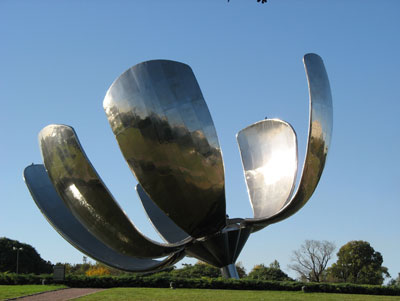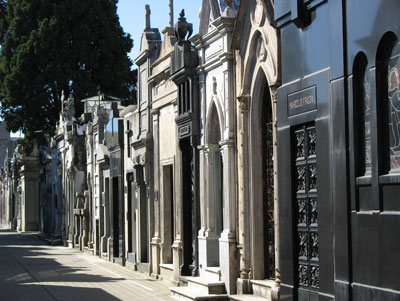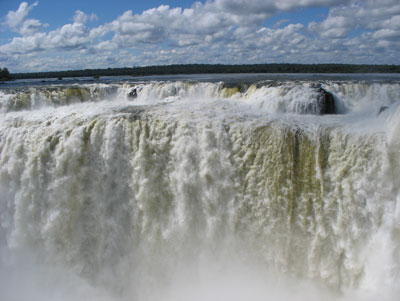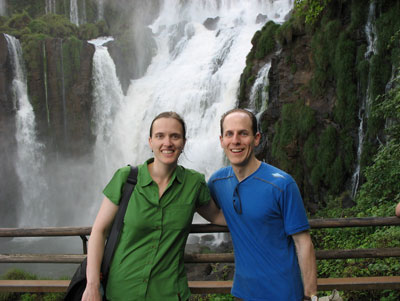Argentina — apartment living in Buenos Aires
by Jennifer Petoff, San Francisco, CA
My husband, Scott, and I visited Buenos Aires in April ’08. It was our first trip to South America and we wanted to make it memorable.
For a number of reasons, we decided to rent an apartment for our 10-day trip rather than stay at a hotel. We expected it would give us a more authentic and local experience and hoped it would provide us the opportunity to be a part of one of the unique barrios that comprise Buenos Aires.
In addition, renting an apartment would cost about half the price of a comparable hotel, making it affordable to rent the apartment for an extra day at both the beginning and end of the trip to better coincide with airport arrival and departure times.
Finally, it would give us a good home base to store our things during overnight trips to Iguazú Falls and Uruguay.
Arriving in the city
We touched down in Buenos Aires after nearly 19 hours en route from San Francisco. We stopped for an alfajor — a double-decker cookie typically filled with dulce de leche and covered in dark or white chocolate — and a café con leche (both local favorites) at the airport to wake ourselves up after the long flight. We then booked a remise (car service) at an airport kiosk (88 pesos, or $27.50) to take us to our apartment in Palermo, an up-and-coming barrio in Buenos Aires.
For safety, and to ensure the best fare, it is recommended that you book a taxi using one of the services at the airport rather than walk up to a vehicle at the curb.
Our flight landed ahead of schedule, so we were really early when we arrived at our apartment building. The building was gated, with 24-hour private security, and there was much fanfare as the security guard welcomed us and tried to figure out what to do with us until the owner showed up.
Our apartment
Sandra, the apartment owner, soon arrived and took us up to Apartment 8B, our home for the next 10 days. We speak a little Spanish and Sandra speaks a little English, so we were able to make ourselves understood to each other with simple phrases in both languages plus ample miming.
The apartment was a beautiful one-bedroom unit with a full kitchen and balcony which we had secured in advance of the trip through ByT Argentina (www.ByT-argentina.com.ar). There were hundreds of units listed online, with detailed information in English about each one and copious pictures.
We selected our unit based on a combination of location, price, recommendations by previous tenants and the charming photos posted. Reserving an apartment through an agency like ByT Argentina is a bit less formal than booking a hotel. We simply submitted a reservation request through the ByT Argentina website and provided our credit card number to reserve the apartment. Payment of rent ($500 for 10 nights) in US dollars was requested upon arrival along with a cash security deposit of $350.
While we always felt safe in Buenos Aires, we took no chances, carrying the cash to pay for the apartment in a security belt under our clothes. It took about 15 minutes to sign the paperwork (much like the lease paperwork one commonly finds in the US) and transfer payment. An English-speaking representative from ByT Argentina was present along with the apartment owner.
Riding the rails
Palermo offers incredibly convenient access to the subway, which was one of the reasons we chose this particular barrio for our stay. Recoleta is another popular, upscale barrio, but public transportation options are more limited there.
We like to take public transportation instead of taxis when we visit different parts of the world, as it provides a glimpse into the lives of the local people that you just can’t get when you wrap yourself in the bubble of a cab. We took the Subte (subway) to Barrio Microcentro (90 centavos, or 25¢) and explored the city. Information on subway routes, rates and passes can be found online, in Spanish only, at www.subte.com.ar.
We enjoyed another coffee at Café Tortoni (Avenida de Mayo 825; www.cafetortoni.com.ar), the oldest and most famous café in Buenos Aires. We walked along the pedestrian-only Calle Florida, which was wall to wall with people. We skirted Plaza de Mayo and cruised along the gargantuan Avenida 9 de Julio to the city’s landmark obelisk before cramming ourselves onto the Subte again during rush hour for the return to Palermo.
Close to our apartment was the Jardín Botánico, home to lush trees and plants, provocative sculptures and dozens of cats, two of which were bold enough to jump onto my lap as I sat on a park bench.
In the evening, Scott and I strolled through Plaza Serrano, located in our neighborhood. We ate dinner at La Paila (Costa Rica 4848; visit [in Spanish only] www.lapaila-restaurante.com.ar), a restaurant also located in Palermo (between Thames and Borges) that featured cuisine from northern Argentina. I had my first taste of Argentine beef in a delicious stew, and Scott had chicken stuffed with quinoa and drenched in honey.
We started our second day in Buenos Aires well rested and ready to explore. The Subte took us to the Palacio de Justicia (Palace of Justice), where we admired the spectacular architecture. We shopped our way back to Microcentro, stopping for empanadas (an inexpensive local favorite) along the way.
We returned home to our apartment and dressed up for the evening, heading out to El Querandí (Perú 302; phone 5411 5199 1770, www.querandi.com.ar) for dinner and a tango show (240 pesos, or $70, per person). Though expensive, the show was fantastic and had a dramatic flair. Three couples shared the stage and each dance told a story — from a loss of innocence to the excitement of finding true love.
The band was incredible and featured a pianist, cellist, bandoneón (accordion) player and violinist. Three cantantes (singers) rounded out the performance.
Barrios San Telmo and La Boca
Making the most of the gorgeous warm weather, we started the next day with a bargain breakfast of café con leche and tres medialunas (three croissants) at a confitería on Avenida Santa Fe, in our neighborhood.
We then took the subway to the San Telmo street market and spent the afternoon happily shopping away, stopping for a huge and very inexpensive lunch on Plaza Dorrego, with the market bustling outside. Complete with appetizer, steak, wine and coffee, our meal cost about $20 for two people, including gratuity.
The day continued to be awash in color as we walked to Barrio La Boca from San Telmo. It was a fair distance (about two miles) and the streets were surprisingly deserted in this area on a Sunday. It may be easier to take a cab if you’re interested in exploring the area.
From La Boca we took a taxi to Puerto Madero, an up-and-coming district of converted warehouses, to check out the beautiful Puente de la Mujer bridge.
We ran into some confusion along the way when the cab driver stopped to get gas. He didn’t speak English and we thought he was asking us to pay for his gas in addition to the fare.
We were further confused when he asked us to step out of the car. We thought he was going to leave us at the gas station!
We were looking around to get our bearings when the driver pointed to the natural gas line under the hood and the methane tank in the trunk of his car. Some rapid-fire español was followed by his saying and miming “Boom!,” and it suddenly clicked. He isn’t allowed to have passengers in the car while it’s being fueled, for safety reasons. Much relieved, we were soon on our way again without a problem.
After people-watching over a diet Coke along the port, we took the Subte back to Palermo, where we enjoyed a quiet evening at home after picking up fresh empanadas at a local bakery. Porteños (the locals) typically do not eat dinner until at least 9 p.m. Having an apartment gave us the option of eating on our own timeline — especially helpful since we had a flight scheduled the next morning at 6 a.m.
Iguazú Falls
We touched down in Puerto Iguazú after a 90-minute flight from Buenos Aires. We left most of our luggage at our apartment in Buenos Aires and traveled light for this overnight trip.
I had heard that some Argentines claim that Niagara Falls is a mere trickle compared to Iguazú. Having grown up in Buffalo, New York, with Niagara Falls in my “backyard,” I looked forward to evaluating Iguazú with my own eyes.
We took a taxi from the airport to the Sheraton Hotel in Parque Nacional Iguazú (www.iguazuargentina.com). The view of the falls in the distance from the hotel lobby was impressive and the jungle setting made for an idyllic scene — but it was no Niagara.
We spent the day hiking the trails near the falls (park entry fee, 40 pesos, or $11.50). The Circuito Superior was gorgeous, but I still felt the Argentines were not justified in their claim of superiority to Niagara. The Circuito Inferior was a more exhausting trail but featured some aptly named falls, like Dos Hermanas (Two Sisters) and Salto Chico (Little Falls). Still, from what I had seen, Iguazú and Niagara were, at best, equals.
At midday we took the short train ride through the jungle to La Garganta del Diablo (Devil’s Throat). The colorful name did not disappoint. We hiked along a series of metal bridges brimming with butterflies of countless varieties and even saw a couple caimans lurking in the water.
Soon we were faced with the raw power of La Garganta. Scott and I were instantly in awe of the volume of water rapidly descending. From this perspective, I had to admit the Argentines are right: Iguazú is a sight to behold!
We capped our day at the falls with La Gran Aventura (www.iguazujunglexplorer.com). Arriving at the river’s edge after a 6-kilometer ride through the jungle in an all-terrain vehicle, we donned life vests, secured our belongings in thick plastic bags and embarked on a speedboat ride to the falls. This cruise made the Maid of the Mist ride at Niagara Falls look incredibly tame in comparison.
The boat actually appeared to go into the falls at one point. To say we got showered would be an understatement. The ride was thrilling, fun and a great way to cool off after a hot afternoon of hiking (120 pesos, or $35, per person).
We were particularly impressed by the dedication of the videographer who came along. He stood on the bow of the boat with his camcorder wrapped in a plastic bag. We thought for certain that he’d fall into the water when we plunged into the falls; he was hanging on with only one hand, since he was working the camera. Amazingly, he made it through safely.
Scott and I enjoyed a buffet dinner at the Sheraton complete with a complimentary caipirinha to toast our day. Tomasito González serenaded diners with his harp stylings.
We spotted one of Iguazú’s famed toucans in a tree before returning to the airport in the morning for our flight back to Buenos Aires.
Adventures in Uruguay
The high-speed ferry, or Buquebus, took us from Buenos Aires to Colonia, Uruguay. We purchased our tickets (115.50 pesos, or $33, per person) prior to our vacation on the Buquebus website (www.buquebus.com).
Colonia was quite picturesque, with boulevards lined with majestic oak trees and remnants of the original town wall. Quaint shops and public squares dotted the town.
We had lunch at a parrilla (steak house) along the water called El Rincón. Of course, steak was the order of the day. El Rincón offered a filet mignon special complete with dessert (chocolate and dulce de leche crepes) and Uruguay’s signature red wine, tannat.
We continued to the capital, Montevideo, with a local bus company (www.turil.com.uy [Spanish only]). We reserved tickets and seats in advance of the trip (about $8) and paid by credit card upon our arrival in Colonia. The one-way trip from Colonia to Montevideo took about three hours.
We enjoyed our first day people-watching, shopping and savoring a meal at a local parrilla, El Fogon. Since Montevideo is on the ocean, we indulged in fish for dinner — a welcome respite from our near-constant diet of beef.
After a good night’s sleep at Hotel London Palace (phone + 598 2 902 0024, www.lphotel.com — about $62 for a double room) and a complimentary breakfast, we set out on foot to explore the Old City. A regular stream of horse-drawn carriages was making deliveries or picking up trash and recycling. It was a surprising anachronism in this modern city.
We finished out the morning by shopping for crafts at a mercado de los artesanos near our hotel. Crafts were surprisingly inexpensive in Uruguay, but some clothing and souvenirs sported US-equivalent prices.
I also was finally able to find a pair of stylish leather shoes in my size at a shoe store across the street from our hotel. I was consistently disappointed in Buenos Aires when shopkeepers kept telling me that their largest size was a 40 (9½ in the US) when I am a 41 (10 in the US). It was almost too much to bear, since there are some fantastic, high-quality shoe stores in Buenos Aires.
We picked up a couple of spicy empanadas at Mercado del Puerto before taking the Buquebus back to Buenos Aires (220 pesos, or $64, per person).
Recoleta
A long walk was called for upon our return from Uruguay, since we’d been indulging in a fair bit of local food and wine. We strolled along Avenida Libertador, past the Italian Embassy, beautiful gardens and majestic statues, on our way from our apartment in Palermo to Recoleta.
Recoleta is a wealthier barrio, and this was clear from the prices in shops and the lack of graffiti on buildings. We enjoyed coffee and lunch outdoors at La Biela (Av. Quintana 600; www.labiela.com) and shopped at another artisans’ market, located outside La Recoleta Cemetery.
We followed a Japanese tour group as they made their way to the tomb of Eva “Evita” Perón. The tombs there were grand, some impeccably maintained and others in a state of disrepair.
We stopped for empanadas at the celebrated El Sanjuanino café (1515 Posadas; www.elsanjuanino.com) to sustain us for the walk back to Palermo, then we hoofed it from Recoleta to Malba, the Latin American Art Museum (Avenida Figueroa Alcorta 3415; www.malba.org.ar). Along the way, we took in the shining metallic sculpture “Floralis Genérica” and the mansions dotting the residential streets off Avenida Figueroa Alcorta.
One final day
Our last day in Buenos Aires included a ride on the city’s oldest Subte line, its cars featuring wood paneling on their interiors.
We got a little confused when we tried to exit the train, as the doors didn’t automatically open when it pulled into the station. We quickly realized that the doors on this classic train are manually operated. Having learned our lesson, we wrenched open the door by hand at the next stop.
A final stroll up Calle Florida capped the afternoon. Yolanda, a colorful porteña at the leather factory Silvia y Mario (M. T de Alvear 550; www.silviaymario.com), helped us pick out two beautiful leather jackets. They were even able to tailor the sleeves on Scott’s jacket in about an hour to ensure a perfect fit.
We finished packing and tidied up the apartment just in time to meet Sandra, reclaim our security deposit and hand over the apartment keys. Sandra greeted us in the traditional Argentine way, with kisses on both cheeks. While we waited for the taxi to arrive, we sat and conversed in a combination of her limited English and our poquito de español, which we had brushed up on before departing for this trip with the Learning Spanish Like Crazy method (www.learningspanishlikecrazy.com).
Sandra was soon bidding us “Bueno viaje,” and the tree-lined streets of Palermo melted away. On the overnight flight home to San Francisco, we dreamed of our fantastic time in South America. Renting an apartment and living the lifestyle of a porteño made for an amazing cultural immersion.





